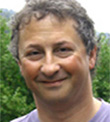Taking Better Aim at Cancer: A Conversation with Gerard Evan

Gerard Evan
Like Isaac Newton long before him, UCSF’s Gerard Evan, PhD, has been elected to an elite club of scientists, the British Royal Society. Indeed, he stands on the shoulders of scientific giants who went before. But Evan is armed with laboratory tools that his scientific forebears could never have imagined. In turn, his work seems destined to give a leg up to the latest generation of pharmaceutical researchers who have set their sights on cancer.
Evan’s refined feats of genetic engineering in mice permit cancers – and potential treatments for eradicating those cancers – to be probed in ever more powerful ways. Based on his latest lab findings, Evan thinks he’s found a very promising drug target – one that has largely been sidelined.
It’s a protein called Myc, a master switch at the hub of the biochemical pathways that govern a cell’s replication into two daughter cells. The gene responsible for Myc production is abnormal or abnormally activated in almost all cancers. In tumor cells, this abnormal Myc becomes an oncogene – a gene that drives uncontrolled growth.
It’s tricky to give patients enough chemotherapy to rid them of tumors without causing life-threatening drug side effects. The older drugs kill all dividing cells, not just cancer cells. Hair falls out; the digestive tract takes a beating; the immune system falters. Newer, targeted treatments are based on a better biological understanding of how cancer cells are different from normal cells.
These new treatments target cancer cells, with fewer side effects in healthy tissue. Among the drugs are several that target proteins abnormally activated in cancer. These include Herceptin for breast cancer, Gleevec for a rare leukemia and a gastrointestinal cancer, Rituxan for non-Hodgkin’s lymphoma, and Tarceva for lung cancer. Many more are in the pipeline.
But aggressive tumors seem to be endlessly resourceful at evolving and changing tack to evade the clutches of even these well-aimed, new drugs. Evan thinks it’s unlikely that tumors will be able to get around drugs that could be developed to target Myc. He has found a way to model what an anti-Myc drug would do to tumors, using mice that are genetically prone to develop lung cancer.
Amazingly, when Myc is switched off, the dividing cancer cells quickly die while normal, healthy, dividing cells merely become dormant. The result, Evan says, is a potent cancer therapy with mild and completely reversible side effects.
On today’s UCSF Science Café, Evan tells us why he thinks pharmaceutical companies should be paying attention.
Alternative content